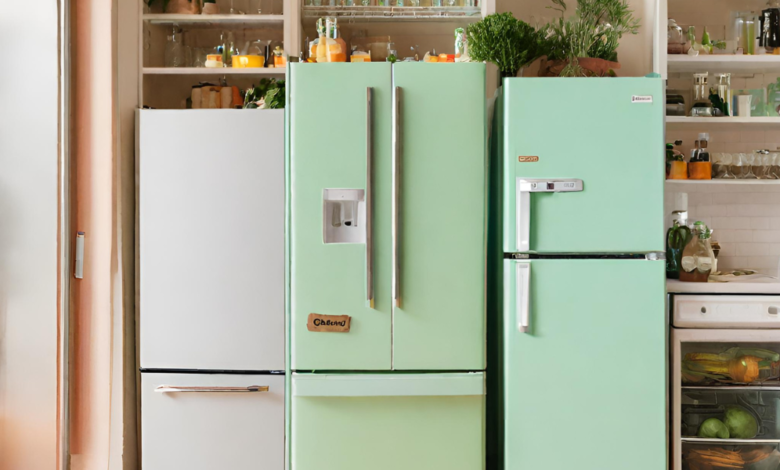Mastering Cleanliness: Hacks to Keep Your Refrigerator Clean and Organized

A clean and organized refrigerator is the cornerstone of an efficient kitchen. Beyond the aesthetic appeal, a well-maintained fridge ensures food safety, reduces waste, and streamlines meal preparation. In this in-depth blog, we’ll delve into a plethora of hacks designed to help you keep your refrigerator in top-notch condition, from clever storage solutions to maintenance routines that will transform your fridge into a model of cleanliness.
The Importance of Refrigerator Maintenance
Maintaining a clean and organized refrigerator is more than just a matter of appearances. It contributes to a healthier kitchen environment, minimizes the risk of foodborne illnesses, and extends the shelf life of your groceries. These hacks are designed to make the process not only effective but also manageable in your daily routine.
Strategic Storage Solutions
1. Zone-Based Organization
Establish clear zones within your refrigerator for different food categories. Designate areas for fruits, vegetables, dairy, meats, leftovers, and beverages. This zoning strategy not only streamlines your organization but also makes it easier to locate specific items.
2. Use Clear Containers and Bins
Invest in clear plastic containers and bins to corral similar items together. This not only enhances visibility but also keeps items neatly separated. Opt for stackable containers to maximize space and create a cohesive look.
3. Lazy Susans for Easy Access
Introduce lazy Susans on your refrigerator shelves, especially for condiments and sauces. These rotating platforms ensure that nothing gets lost at the back of the shelf, providing easy access to items with a simple spin.
Creative Storage Solutions
4. Hanging Storage Pockets
Utilize the vertical space on the inside of your refrigerator door by attaching hanging storage pockets. These pockets can hold small items like condiment packets, spices, or even grocery lists, maximizing door space.
5. Egg Cartons for Small Items
Repurpose empty egg cartons for storing small items like condiment packets, olives, or small fruits. Place them in the door compartments or on a designated shelf to prevent these smaller items from getting lost.
6. Magnetic Spice Jars
Transform the interior side of your fridge door into a magnetic spice rack. Use small magnetic jars to store frequently used spices. This not only saves shelf space but also keeps essential flavorings easily accessible.
Maintaining Cleanliness
7. Baking Soda Deodorizer
Place an open box of baking soda on one of the refrigerator shelves to absorb any lingering odors. Replace it every few months to ensure its effectiveness in maintaining a fresh-smelling interior.
8. Regular Cleanouts
Schedule regular cleanouts to remove expired items, wipe down shelves, and assess the overall condition of your refrigerator. This practice not only keeps your refrigerator tidy but also helps prevent the development of unpleasant odors.
9. Fridge Coasters for Condensation
Combat condensation issues with fridge coasters. These absorbent liners can be placed on shelves to collect excess moisture, preventing vegetables and fruits from becoming soggy. They come in various designs and can be easily cleaned or replaced.
Temperature Control and Placement
10. Top, Middle, and Bottom: Temperature Zones
Understand the temperature variations within your refrigerator. The top shelf tends to be warmer, making it ideal for items that don’t require extreme cold, such as leftovers and ready-to-eat foods. The middle shelves are perfect for dairy, while the bottom is best for raw meats and fish.
11. Door Storage Wisdom
The refrigerator door is the warmest part of the appliance, making it suitable for items with a longer shelf life, like condiments and beverages. Avoid storing sensitive items like dairy or eggs in the door, as temperature fluctuations can affect their freshness.
12. Crisper Bins for Humidity Control
Make the most of your fridge’s produce drawers. Use one for fruits and another for vegetables, organizing them based on ethylene gas production. Ethylene-producing fruits like apples can be kept separate to prevent premature ripening of other produce.
Space-Saving Techniques
13. DIY Fridge Door Pocket Organizer
Turn fabric or plastic placemats into pocket organizers for your fridge door. Attach them using adhesive hooks or strips, and use the pockets to store smaller items like ketchup packets, butter, or small condiment bottles. This not only adds extra storage but also keeps the door clutter-free.
14. Suction Cup Spice Rack
Optimize the side walls of your fridge by creating a DIY spice rack using suction cups and small containers. Fill these containers with commonly used spices and herbs, placing them within easy reach for convenient cooking.
15. Stackable Storage Crates
Craft stackable storage crates using wooden or plastic boxes. Attach small casters to the bottom for easy mobility and stack them to create a tiered storage system. This is particularly useful for organizing fruits, vegetables, and snacks in a visually appealing manner.
Labeling and Inventory Management
16. Chalkboard Labels on Jars
Enhance the visual appeal of your DIY storage solutions by adding chalkboard labels to jars or containers. Use chalk or chalkboard markers to identify the contents, making it easy to update labels as needed and maintain an organized system.
17. Color-Coded Shelf Markers
Implement a color-coding system for your fridge shelves. Assign specific colors to different categories such as dairy, produce, and leftovers. Create colored markers using paint or adhesive tape to guide family members in returning items to their designated spots.
18. Binder Ring Label Tags
Craft label tags using binder rings and durable cardstock. Attach these tags to bins or containers to clearly mark their contents. This DIY labeling system adds a touch of organization while allowing for easy adjustments as your fridge contents evolve.
Family-Friendly Strategies
19. Consider Family Habits
Tailor your organization system to match the habits of your household. If you have children, create a low shelf with healthy snacks they can easily access. Understanding the dynamics of your family life ensures a system that everyone can follow.
20. Rotate Stock Regularly
Practice the “first in, first out” rule to prevent food waste. When restocking groceries, place new items behind older ones. This simple rotation system ensures that older products are used before they expire.
21. Weekly Family Meeting for Fridge Check-In
Establish a weekly family meeting that includes a quick fridge check-in. Discuss upcoming meals, review any items that need attention or replenishment, and collectively plan for the week ahead. This fosters a sense of responsibility among family members.
Innovative Cleaning Hacks
22. Vinegar and Water Solution for Cleaning
Create a natural cleaning solution using equal parts white vinegar and water. Use this mixture to wipe down shelves, drawers, and the interior of the fridge. The vinegar helps disinfect surfaces and eliminate odors.
23. Activated Charcoal for Odor Absorption
Place activated charcoal in an open container in your fridge to absorb unwanted odors. Activated charcoal is highly effective at neutralizing smells and can be refreshed by placing it in direct sunlight for a few hours.
24. Lemon and Salt Scrub for Stains
Remove stubborn stains from your
refrigerator with a mixture of lemon juice and salt. The acidity of the lemon combined with the abrasiveness of the salt creates a powerful yet natural scrub. Apply this mixture to stains, let it sit for a few minutes, and then wipe clean.
Meal Planning and Inventory Management
25. Designate a Snack Zone
Create a dedicated area for snacks, making it easy for family members to find and grab their favorite treats. This can be a specific drawer or a designated shelf, streamlining snack time and reducing the chances of items being scattered throughout the fridge.
26. Inventory Tracking App
Explore smartphone apps designed for inventory tracking. These apps allow you to input items as you purchase them and remove them as they are used. Some apps even provide alerts for upcoming expiration dates, helping you stay on top of your inventory.
27. Fridge Whiteboard for Notes and Lists
Place a whiteboard on the outside of your fridge for notes, lists, and meal plans. This serves as a central communication hub for the family, ensuring everyone is aware of what’s inside the fridge and any upcoming culinary plans.
Sustainable and Eco-Friendly Practices
28. Reusable Produce Bags
Replace single-use plastic produce bags with reusable mesh bags. These bags are perfect for storing fruits and vegetables and can be easily washed and reused. They contribute to a more sustainable and eco-friendly kitchen.
29. Beeswax Wrap for Food Storage
Reduce your reliance on plastic wrap by using beeswax wraps. These reusable wraps mold around food items and containers, creating a seal that helps maintain freshness. They are washable and can be used for various types of food storage.
30. Glass or Stainless Steel Containers
Opt for glass or stainless steel containers instead of plastic for food storage. These materials are more durable, free from harmful chemicals, and contribute to a greener kitchen by reducing the use of disposable plastic.
Conclusion
A clean and organized refrigerator is not only a visual delight but also a practical asset in any kitchen. By incorporating these hacks into your routine, you can create a system that is easy to maintain and tailored to the needs of your household. Experiment with different strategies, adapt them to your preferences, and enjoy the benefits of a well-organized and pristine refrigerator. Happy cleaning and organizing!






